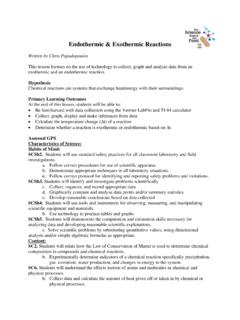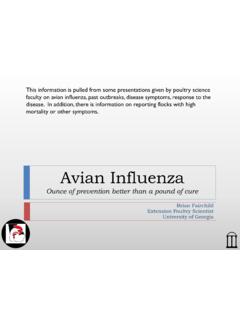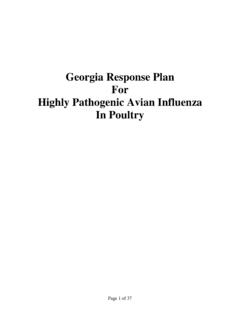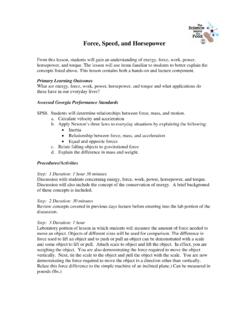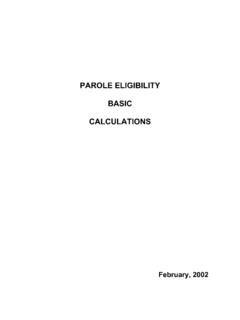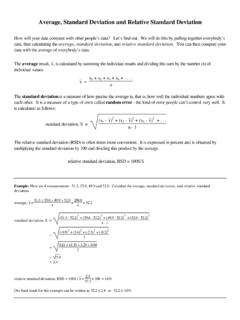Transcription of PESTICIDE RATE AND DOSAGE CALCULATIONS
1 31 UGA Extension Special Bulletin 28 Georgia Pest Management Handbook 2020 Commercial Edition3. To find the amount of wettable powder (WP) or liquid concentrate to use in a given amount of spray:amt. of WP or liq. conc. = no. of acres treated with amount of spray X desired amount of WP or liq. conc. per acre**Trees, animals, etc. can be substituted for To find the pounds of wettable powder needed to obtain a desired percentage of active ingredient in water:5. To find the gallons of liquid concentrate needed to obtain a desired percentage of active ingredient in water:** One gallon of water weighs approximately pounds. If another diluent is used the weight per gallon of the other diluent should be substituted for for use in sprays are generally available as wettable or soluble powders and as liquid concentrates. These must be diluted, usually with water, before use. Other diluents, such as deodorized kerosene, may be used for special precise amount of water applied to an acre (or other given area) is of modest concern as long as volume falls within a recommended range, delivers the recommended amount of PESTICIDE , provides adequate coverage, and does not result in excessive runoff or drift.
2 If you know the area (acres, sq ft, etc.) or units (trees, cows, etc.) covered by a given amount of spray you can determine the DOSAGE or rate of active ingredient each receives by adding the proper quantity of PESTICIDE to that amount of water. Dusts and granules are applied without dilution by the user. Therefore, the amount applied per acre or other unit is much more critical because you have no other way of controlling the DOSAGE or rate of active amount of active ingredient in liquid concentrates is expressed in pounds per gallon. In granules, dusts, wettable or soluble powders, and other solids it is nearly always expressed as percent by weight. Application rates are usually expressed as amount of PESTICIDE product but sometimes they may be expressed as pounds of active ingredient or actual toxicant. Actual toxicant and active ingredient are practically To find the pounds of wettable powder (WP), dust (D) or granules (G) per acre to obtain the desired pounds of active ingredient (ai) per acre:2.
3 To find the pints of liquid concentrate per acre to obtain the desired pounds of active ingredient (ai) per acre: * If you want the answer in gallons, quarts, or fluid ounces substitute l, 4, or l28 respectively for of WP, D, or G per acre =lbs ai desired x 100% ai in WP, D, or Gconc. per acre =lbs. ai desired x 8*lbs ai per gallon of liq. of WP =gals of spray desired x % ai desired x **% ai in WPgal of liq. conc. =gals of spray desired x % ai desired x **lbs ai per gal of liq. conc. x 100 PESTICIDE RATE AND DOSAGE CALCULATIONSM ilton D. Taylor, Associate Coordinator, PSEPHOW TO CALCULATE PESTICIDE DILUTIONS AND DOSAGES FOR LARGE AREAS32 UGA Extension Special Bulletin 28 Georgia Pest Management Handbook 2020 Commercial EditionPESTICIDE RATE AND DOSAGE CALCULATIONSPESTICIDE CONVERSION TABLE FOR LARGE AREASLIQUID FORMULATIONSA mount of Commercial Product to Add to Spray Tank for Each Acre TreatedFORMULATION LBS/GAL ACTIVE INGREDIENTD esired Rate Per Acre of Active Ingredient.
4 Oz17 oz26 oz34 oz43 oz51 oz64 oz85 oz96 oz128 oz171 oz213 oz256 oz341 oz512 oz768 oz28 oz13 oz19 oz26 oz32 oz38 oz48 oz64 oz72 oz96 oz128 oz160 oz192 oz256 oz384 oz576 oz35 oz9 oz13 oz17 oz21 oz26 oz32 oz43 oz48 oz64 oz85 oz107 oz128 oz171 oz256 oz384 oz44 oz6 oz10 oz13 oz16 oz19 oz24 oz32 oz36 oz48 oz64 oz80 oz96 oz128 oz192 oz288 oz9 oz11 oz13 oz16 oz21 oz24 oz32 oz43 oz53 oz64 oz85 oz128 oz192 oz21 oz29 oz38 oz48 oz57 oz76 oz115 oz172 oz11 oz18 oz20 oz27 oz37 oz46 oz55 oz73 oz110 oz165 oz82 oz8 oz12 oz16 oz18 oz24 oz32 oz40 oz48 oz64 oz96 oz144 ozWETTABLE POWDER FORMULATIONSP ounds of Commercial Product to Add to Spray Tank for Each Acre Treated% ACTIVEINGREDIENTD esired Rate Per Acre of Active Ingredient, Extension Special Bulletin 28 Georgia Pest Management Handbook 2020 Commercial EditionCONVERSION TABLES FOR SMALL AREASLIQUID FORMULATIONS1 Amount of Commercial Product to Add to Spray Tank to Treat l000 Sq FtFORMULATION LBS/GAL ACTIVE INGREDIENTD esired Rate Per Acre of Active Ingredient, Tbsp1( )33 oz2( )6 oz( )11 oz 1 Tbsp( )11 Tbsp 1 tsp( )3 Tbsp( )3 oz( )5 oz 1 Tbsp( )22 tsp( )1 Tbsp 1 tsp( )3 Tbsp( )3 oz( )5 oz 1 Tbsp( )11 oz 1 Tbsp( )41 tsp( )2 tsp( )1 Tbsp 1 tsp( )3 Tbsp( )3 oz( )6 oz( )7 oz 2 tsp( )8 oz 4 tsp( ) PESTICIDE RATE AND DOSAGE CALCULATIONSPESTICIDE CONVERSION TABLE FOR LARGE AREAS (continued)
5 GRANULES AND DUSTSP ounds of Commercial Product to Apply Per Acre% ACTIVE INGREDIENTD esired Rate Per Acre of Active Ingredient, approximate values2 refers to level measure3 figure in parentheses refers to milliliters34 UGA Extension Special Bulletin 28 Georgia Pest Management Handbook 2020 Commercial EditionPESTICIDE RATE AND DOSAGE CALCULATIONSCONVERTING LARGE VOLUME RECOMMENDATIONS TO SMALL VOLUMES OR AREAS1. To find the amount of liquid concentrate per gallon when label recommendations are given in pints per 100 gallons:teaspoons/gallon = recommended pints per 100 gallons x 1*orteaspoons/gallon = recommended pints per l00 gallons x = recommended pints per 100 gallons x *2. To find the amount of wettable powder (WP) or other solid formulation per gallon when label recommendations are given as pounds per 100 gallons:teaspoons/gallon = recommended lbs/100 gals x cups in 1 lb of formulation x *orteaspoons/gallon = recommended lbs/100 gals x Tbsps in 1 oz of formulation x *or grams/gallon = recommended lbs/100 gals x *Frequently, PESTICIDE recommendations are given only for large volume applications, amount per l00 gallons or per acre, but only a small amount is needed.
6 Conversion of liquids to smaller quantities is relatively easy and precise because suitable equipment such as measuring spoons are readily available. While scales sensitive enough to handle small quantities of solid materials are available, it is often more practical to use volumetric measures. Various conversion tables have been prepared on the premise that there are 200 to 300 teaspoons (roughly 2-3 pints) per pound of solid PESTICIDE product. These tables are grossly inaccurate because of the wide variation in bulk density among solid PESTICIDE formulations. For instance, a pint of almost any insecticide wettable powder will weigh much less than a pint of fungicide that has a high metal content. Greater accuracy can be obtained if one first determines the weight of a given volume of the solid material and then calculates the volumetric measure. This will usually provide acceptable accuracy but it is still not as accurate as actually weighing a solid formulation.
7 When coupled with a little simple arithmetic the following formulas will enable you to convert large volume recommendations to smaller quantities:3. To find the amount of liquid concentrate to apply per 1000 square feet when label recommendations are given as pints per acre:teaspoons/1000 sq ft = recommended pints/acre x *ormilliliters/1000 sq ft = recommended pints/acre x *4. To find the amount of dust (D), granules (G) or wettable powder (WP) to apply per 1,000 square feet when label recommendations are given as pounds per sq ft = recommended lbs/acre x *orTbsps/1000 sq ft = recommended lbs/acre x cups in 1 lb of formulation x *orTbsps/1000 sq ft = recommended lbs/acre x Tbsps in 1 lb of formulation x *orgrams/1000 sq ft = recommended lbs/acre x **These values have been rounded off to facilitate Extension Special Bulletin 28 Georgia Pest Management Handbook 2020 Commercial EditionThe procedure below is based on spraying 1/128 of an acre per nozzle or row spacing and collecting the spray that would be released during the time it takes to spray the area.
8 Because there are 128 ounces of liquid in 1 gallon, this convenient relationship results in ounces of liquid caught being directly equal to the application rate in gallons per with clean water when applying toxic pesticides mixed with large volumes of water. Check uniformity of nozzle output across the boom. Collect from each for a known time period. Each nozzle should be within 10 percent of the average output. Replace with new nozzles if necessary. When applying materials that are appreciably different from water in weight or flow characteristics, such as fertilizer solutions, etc., calibrate with the material to be extreme care and use protective equipment when active ingredient is 1. Determine type of application to be made and select appropriate procedure from Table 1. For example, for a Herbicide Broadcast, use Procedure A. Note: Determine and use average row spacing for modified row patterns. In skip row patterns, use width of area covered per row as row 2.
9 Using procedure A, B, or C below as selected in Step 1, determine appropriate calibration distance from Table 1. Corresponding procedures for different spray OF APPLICATIONPROCEDURECOVERAGE BASISH erbicide, Insecticide, Nematicide, Fungicide, or Liquid FertilizerBroadcastABroadcast (gal/acre)BandBBroadcast (gal/acre of band)Row (See note)C (Use this procedure when rates are given for row treatment)CALIBRATION METHOD FOR HYDRAULIC BOOM AND BAND SPRAYERS, AND OTHER LIQUID APPLICATORSGary L. Hawkins, Extension EngineerGlen C. Rains, Extension Engineer(A) Broadcast Application: Outlets or nozzles must be evenly spaced. Measure outlet (nozzle, etc.) spacing. Find this spacing in left column of Table 2 and read the corresponding calibration distance. For example, for a 19-inch spacing, the distance would be feet.(B) Band Application: Measure band width. Find this band width in the left column of Table 2 and read the corresponding calibration distance. For example, for a 12-inch band, the distance would be feet.
10 (C) Row Application: Measure row spacing for evenly spaced rows. Find this row spacing in the left column of Table 2 and read the corresponding calibration distance from the column on the right. For example, for a 38-inch row spacing, the distance would be feet. (See note above for modified and skip rows.)Step 3. Measure and mark calibration distance in a typical portion of the field to be 4. With all attachments in operation (harrows, planters, etc.) and traveling at the desired operating speed, determine the number of seconds it takes to travel calibration distance. Be sure machinery is traveling at full operating speed the full length of the calibration distance. Mark or make note of engine RPM and gear. Machine must be operated at same speed for : AGRICULTURAL CHEMICALS CAN BE DANGEROUS. IMPROPER SELECTION OR USE CAN SERIOUSLY INJURE PERSONS, ANIMALS, PLANTS, SOIL, OR OTHER PROPERTY. BE SAFE. SELECT THE RIGHT CHEMICAL FOR THE JOB. HANDLE IT WITH CARE.

